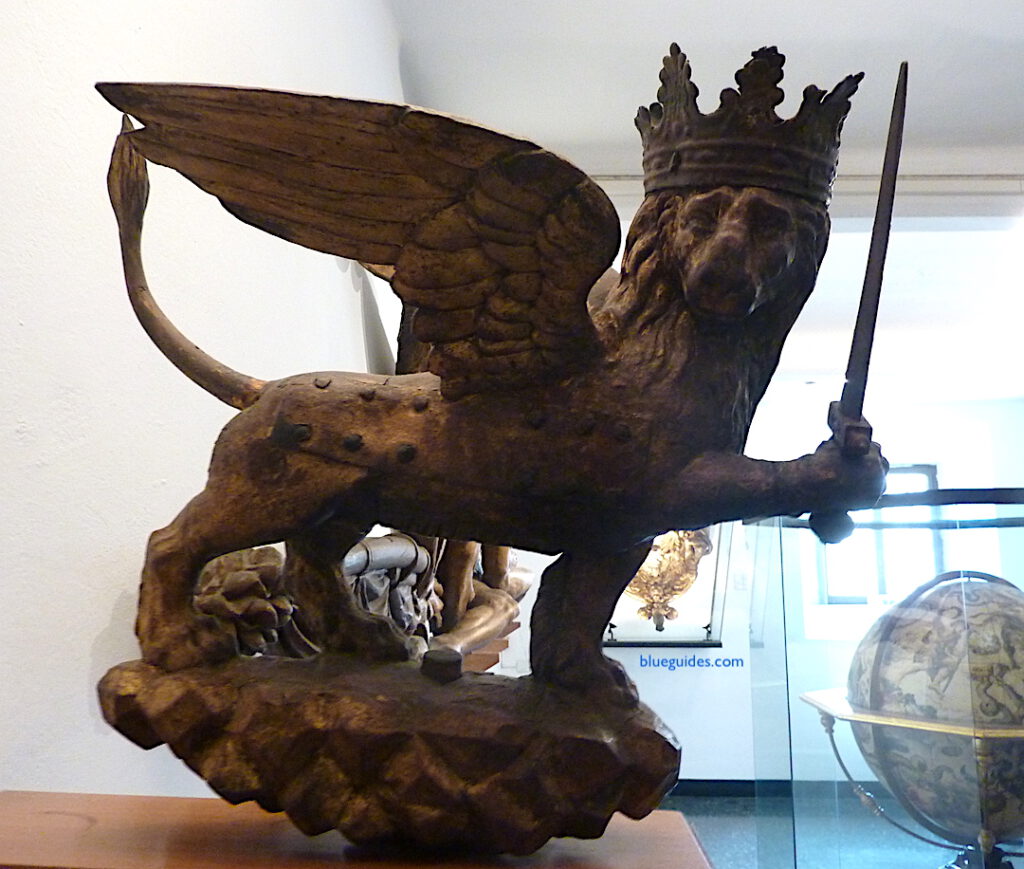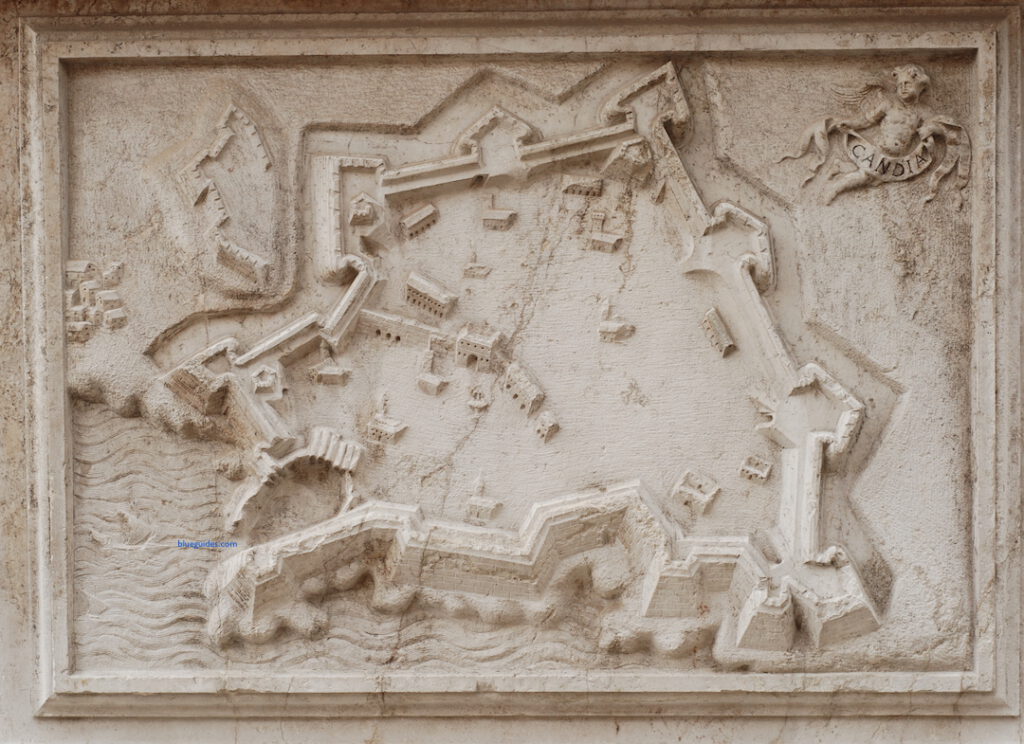
The Venetian Empire, or Stato da mar, depended on a huge number of galleys, galleons and galleasses to protect its trade routes to the east. As Jan Morris has pointed out, ‘in an age when seamen preferred to spend their nights ashore’ the Republic soon set about establishing control of coastal ports in Dalmatia, Corfu, on the Greek mainland, in Crete, Alexandria and Cyprus for her merchant ships plying back and forth between Venice and Constantinople and further east. By the 15th century the ships could depend on being welcomed into ports under the control of the Serenissima throughout their journey. For safety against attacks from pirates or by the Turks they would sail in convoy: the concern for their safe return is wonderfully portrayed in the opening scene of Shakespeare’s Merchant of Venice.
The galleys were of various sizes – small and thin; biremes with two tiers of oars, and triremes with three. By the 16th century the longer quinqueremes were in use, with their five horizontal levels of oars (and with five men to an oar). Galleons, which were armed merchant ships, were even larger, redesigned in the first half of the 16th century by the Venetian Humanist Vettor Fausto (a member of the erudite circle of Aldus Manutius, through whom he was able to study the history of naval construction in Greek and Latin texts). It was Fausto who pioneered the concept of marine architecture. In the 17th century the galleass was designed. A cross between a traditional galley and a galleon, equipped with four masts, broad in the beam and propelled by hundreds of oars, its role was to provide a line of defence preceding the rest of the fleet when naval battles were predicted.
We know that a flotilla of six great galleasses led the Venetian fleet into battle against the Ottoman Empire in 1571, at Lepanto at the entrance to the Gulf of Corinth. It has gone down in history not only as a famous Venetian victory but also as the last sea battle to be fought with galleons manned by oarsmen. Although there were terrible losses on both sides (at least 8,000 on the Christian side and some 20,000 on the Muslim), it was always considered a great victory by the Venetians and there are painted and sculpted memorials to it in buildings all over Venice. We know that the ship which returned to Venice bringing news of the victory took just ten days to reach the lagoon.
Some Venetian ships had to be flat-bottomed to transport cavalry horses. Other live animals were kept on deck for food during a voyage. In siege warfare the masts could sometimes be turned into ladders to set up against the walls of enemy fortresses. Because of the shallowness of the lagoon, some of the larger ships had to be raised on pontoons (known as camelli) for their safe passage to the open sea. On their return, the boats would put in at quays all over the city, although the Bacino di San Marco in front of the Doge’s Palace was always the main harbour. This was where illustrious visitors would disembark and where the doge boarded the Bucintoro for the annual ceremony of Venice’s ‘marriage’ with the sea.
The Captain-Generals of the Sea, often became heroes (and even doges) after victories; but if defeated they could be disgraced and imprisoned. The most celebrated Admiral of the Fleet was Francesco Morosini, who came from a well-known Venetian patrician family, many members of which served the Republic over the centuries, four of them becoming doges. After achieving great fame for his military exploits, Francesco himself became Venice’s last great doge. He began his career on the island of Crete, which had been taken by the Serenissima in 1204 as part of her ‘reward’ after the Fourth Crusade. Following the takeover, and once the Genoese were ousted, Venice settled down to centuries of fruitful occupation of the island, having secured it as a roadstead for the merchant galleys bound for Alexandria and for Constantinople and beyond. When the Turks laid siege to Herakleion in the 17th century, Morosini took command of the defence of the town and held out for an incredible 22 years—the longest siege in history. The townspeople endured terrible suffering and when Morosini finally surrendered, in 1669, the island fell to the Turks. Morosini himself survived and his troops were allowed to leave Crete unharmed (but not before Morosini had managed to steal the precious icon of the Madonna from Herakleion cathedral; it has been on the high altar of the church of the Salute in Venice ever since).

Morosini also enjoyed capturing flags, shields and armour from the Turks (all his trophies have been preserved). He always went to sea with his cat, and parts of the galleys he sailed are today preserved in museums in Venice. He had a prayer book specially made so that it could conceal a small pistol; his sword is one of the most unexpected ‘treasures’ in the basilica of St Mark’s. However, Morosini is best remembered by Venetians for his conquest of the Peloponnese in 1685–7. He had given the Republic its last moment of glory and ever afterwards he was known to its people as the ‘Peloponnesiaco’. The magnificent ancient lions he seized from Greece during these campaigns are still seated outside the gate into the Arsenale.
Outside Venice, Morosini’s name in history is indelibly linked with the Parthenon, since before he finally took possession of the Peloponnese, he allowed his German mercenary troops to bombard the Acropolis, where the Turks had set up their defences. By the time he reached Athens, the Turks had already demolished what was left of the Propylaia (it had been hit by lightning and ruined in an explosion some years earlier when it served as an ammunition store) and they had totally destroyed the Temple of Athena Nike just inside the entrance gate, setting up their artillery on the bastions. They were using the Parthenon as a powder magazine and one evening in the following year, 1687, a mortar from Morosini’s position on the Mouseion Hill was fired by a mercenary lieutenant directly at the Parthenon. The explosion carried away practically the whole of the temple’s cella and its frieze, as well as eight columns on the north side and six on the south side, together with the entablature. The world-famous temple was effectively cut in half. Morosini, on taking the hill, then added to the damage by attempting to remove the west pediment. He bungled it and the precious sculptures of the chariot of Athena and its horses fell to the ground and were smashed to pieces. The Venetians overlooked this and when Morosini returned home he was welcomed as a hero and was elected doge shortly afterwards. The Peloponnese remained under Venetian control for the next 30 years, but not without forays from the Turks. Fittingly enough, he died in battle within sight of the walls of Nafplion in 1694, yet again fighting the Ottomans.
by Alta Macadam, author of Blue Guide Venice.






